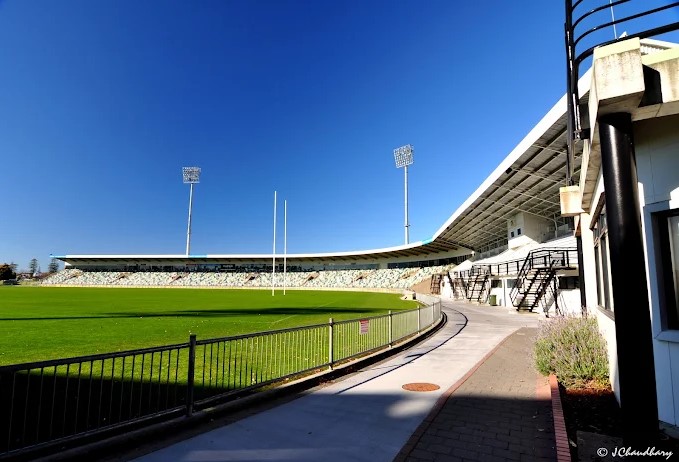Nestled in the heart of Napier, on New Zealand’s North Island, McLean Park stands as one of the most iconic cricket venues in the country. Known for its lush outfield, flat pitches, and often batting-friendly conditions, it has hosted numerous international matches over the decades. One of the key attributes that define a cricket ground’s playability and strategy is its boundary length, and McLean Park offers a unique profile in this regard.
Table of Contents
This article explores the boundary dimensions of Napier’s McLean Park, how they affect gameplay, and compares them with other famous cricket grounds worldwide.
Overview of McLean Park
| Feature | Detail |
|---|---|
| Official Name | McLean Park |
| Location | Napier, Hawke’s Bay, New Zealand |
| Established | 1911 |
| First International Match | 1979 (ODI) |
| Seating Capacity | Approx. 19,700 |
| Pitch Type | Flat, batting-friendly |
| Known For | High-scoring ODIs, even bounce |
Boundary Lengths at McLean Park
Unlike some larger cricket stadiums, McLean Park has relatively short boundaries, especially on the square sides. The dimensions can vary slightly depending on pitch placement for a particular match, but here are the typical average boundary lengths:
| Direction | Approximate Length (in meters) |
|---|---|
| Straight (North-South) | 75 – 77 m |
| Square (East-West) | 62 – 65 m |
| Mid-wicket/Extra cover | 68 – 70 m |
| Behind square | 60 – 64 m |
These dimensions make McLean Park a favorite among power-hitters, especially during the shorter formats like T20s and ODIs. Bowlers, especially spinners and pacers who rely on slower balls, often need to adjust their lines due to the shorter square boundaries.
Influence on Match Strategy
For Batsmen
- Left-handers often dominate the square leg region.
- Right-handers target deep point and extra cover.
- Power hitters often focus on lofted square drives and slogs over midwicket.
For Bowlers
Bowlers often adjust their lines and lengths to combat the short boundaries:
- Fast bowlers bowl wider of the off-stump or go full and straight to reduce horizontal bat shots.
- Spinners flight the ball less and bowl flatter to minimize chances of being hit square.
For Captains
Field placements are strategic:
- Square boundary fielders are pushed deeper.
- Inner circle fielders are used to block singles to keep pressure on batsmen targeting the boundary.
- Risk-reward strategies are more common — encouraging batsmen to take aerial routes toward longer boundaries.
Comparison With Other Grounds
To understand Napier’s unique dimension profile, it’s helpful to compare it with other popular international venues.
| Stadium | Location | Square Boundary | Straight Boundary | Avg. Total in ODIs |
|---|---|---|---|---|
| McLean Park (Napier) | New Zealand | 62 – 65 m | 75 – 77 m | 280 – 300 |
| Eden Gardens | India | 66 – 69 m | 76 – 78 m | 260 – 280 |
| MCG | Australia | 80 – 85 m | 83 – 86 m | 240 – 270 |
| Wankhede Stadium | India | 63 – 65 m | 70 – 73 m | 280 – 300 |
| Newlands (Cape Town) | South Africa | 64 – 66 m | 72 – 74 m | 270 – 290 |
Memorable Matches Highlighting the Boundary Factor
1. New Zealand vs India – ODI, January 2014
- Total Score: NZ 292/7, India 288 all out
- Sixes: 15
- Commentary Insight: Short square boundaries were targeted repeatedly by both teams, especially by Virat Kohli and Corey Anderson.
2. New Zealand vs West Indies – 2015
- Score: NZ 373/8
- Sixes: 22
- Highlight: Martin Guptill’s explosive innings featured multiple sixes over midwicket and square leg — areas made easier to target due to the ground’s shape.
Impact on Fielding and Spectatorship
Shorter boundaries not only influence scoring but also:
- Increase the number of catches at the boundary rope, making for thrilling spectator moments.
- Bring more crowd engagement, especially with frequent sixes.
- Challenge fielders to be highly athletic on the ropes — tip-toeing and leaping catches are common.
Technological Advancements and Boundary Adjustments
Like many modern grounds, McLean Park uses movable boundary ropes to allow flexibility depending on the format. For example:
- ODIs often use full-length boundaries.
- T20s may bring ropes in by 2–4 meters to ensure high-scoring games.
- Test matches usually feature full-size boundaries for balance.
Renovations and Modern Use
Why Boundary Size Matters at Napier
| Factor | Impact at McLean Park |
|---|---|
| Short square boundaries | High six count, batsman-friendly |
| Long straight boundaries | Bowlers use yorkers, back-of-length balls |
| Oval shape | Unique scoring areas, fielding pressure |
| Wind factor | Helps or hinders six-hitting depending on direction |
McLean Park in Napier is a ground that rewards positive intent — especially for batsmen who can take advantage of the short square boundaries. Its boundary layout, combined with flat pitches and an often windy atmosphere, makes it a venue where thrilling cricket is almost guaranteed. From massive totals to heroic chases, the ground has a way of delivering memorable matches, driven largely by its unique physical dimensions.
As cricket continues to evolve, especially in T20 formats, boundary length remains a key tactical element — and in Napier, it’s one that defines the ground’s very character.


